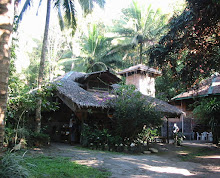Por qué el concepto materialista, neo-darwinista del universo es casi con certeza falsa....la visión materialista simplemente no puede explicar el Universo, no puede explicar el hecho de que parece haber un propósito en el Universo, lo cual el materialismo niega. Y no puede explicar la existencia de la conciencia humana".
I saw this video of Rupert Sheldrake last night and he talks about the world view of Animism -- the quintessential Filipino worldview and relationship with the world -- and how it is making much more SENSE in the era of Quantum Mechanics and the study of the human consciousness.
I really urge you to listen to this scientist refute materialism:
Vi este video anoche, de una charla de Rupert Sheldrake, en que habla sobre la visión del mundo del Animismo - la quintaesencia de la cosmovisión filipina y de nuestra relación con el mundo - y cómo está haciendo mucho más SENTIDO en la era de la Mecánica cuántica y el estudio de la conciencia humana.
Les pido encarecidamente que escuchen a este científico refutar el materialismo:.
Rupert Sheldrake - Is The Sun Conscious?
I know, I know, it sounds really outrageously New Age, but it's (1) to reel you in by engaging your humorous curiosity, and (2) it really is an interesting way to stretch the limits of our conception of Reality, which is SO FLAT anyhow and overdue (like, 2,000 years) for a good stretching and elongation, as in yoga.
Lo sé, lo sé, suena escandalosamente New Age, pero es (1) la intención es atraer tu curiosidad humorística, y (2) es una manera interesante de empujar y estirar los límites de nuestra concepción de la Realidad, que de todas formas está TAN PLANA y hace un buen rato (como 2.000 años) que necesitaba un buen estiramiento y elongación, como en el yoga.
And for my dear blog visitors who have a
hard time understanding spoken English but can read subtitles, just turn on the subtitle box and the English subs will appear. You can just pause and read. I doubt there is a Spanish subtitled version yet.
Y para mis queridos visitantes del blog que tienen dificultades para entender el inglés hablado pero que pueden leer subtítulos, sólo tienen que activar la casilla de subtítulos y aparecerán en inglés. Puedes hacer una pausa y leer. Dudo que haya todavía una versión subtitulada en español.
¡Un beso y un abrazo desde los Andes!
A Big Hug and a Kiss from the Andes!!!
.....there are all these words down here that are repeated from a paragraph above...don't mind them...I'll stick in some pretty bees...
...hay una duplicación de un párrafo de más arriba, no hagan caso...voy a meter algunas abejitas bonitas....
y habla sobre la visión del mundo del Anim
Les pido encarecidamente que escuchen a este científico refutar el materialismo:



